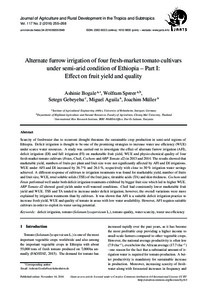| dc.date.accessioned | 2016-11-14T14:56:31Z | |
| dc.date.available | 2016-11-14T14:56:31Z | |
| dc.date.issued | 2016-11-14 | |
| dc.identifier.issn | 1612-9830 | |
| dc.identifier.issn | 2363-6033 | |
| dc.identifier.uri | urn:nbn:de:hebis:34-2016092050949 | |
| dc.identifier.uri | http://hdl.handle.net/123456789/2016092050949 | |
| dc.language.iso | eng | |
| dc.publisher | Kassel University Press | ger |
| dc.rights | Urheberrechtlich geschützt | |
| dc.rights.uri | https://rightsstatements.org/page/InC/1.0/ | |
| dc.subject | deficit irrigation | eng |
| dc.subject | tomato (Solanum lycopersicum L.) | eng |
| dc.subject | tomato quality | eng |
| dc.subject | water scarcity | eng |
| dc.subject | water use efficiency | eng |
| dc.subject.ddc | 630 | |
| dc.title | Alternate furrow irrigation of four fresh-market tomato cultivars under semi-arid condition of Ethiopia – Part I: Effect on fruit yield and quality | eng |
| dc.type | Aufsatz | |
| dcterms.abstract | Scarcity of freshwater due to recurrent drought threatens the sustainable crop production in semi-arid regions of Ethiopia. Deficit irrigation is thought to be one of the promising strategies to increase water use efficiency (WUE) under scarce water resources. A study was carried out to investigate the effect of alternate furrow irrigation (AFI), deficit irrigation (DI) and full irrigation (FI) on marketable fruit yield, WUE and physio-chemical quality of four fresh-market tomato cultivars (Fetan, Chali, Cochoro and ARP Tomato d2) in 2013 and 2014. The results showed that marketable yield, numbers of fruits per plant and fruit size were not significantly affected by AFI and DI irrigations. WUE under AFI and DI increased by 36.7% and 26.1%, respectively with close to 30% irrigation water savings achieved. A different response of cultivars to irrigation treatments was found for marketable yield, number of fruits and fruit size, WUE, total soluble solids (TSS) of the fruit juice, titratable acids (TA) and skin thickness. Cochoro and Fetan performed well under both deficit irrigation treatments exhibited by bigger fruit size which led to higher WUE. ARP Tomato d2 showed good yields under well-watered conditions. Chali had consistently lower marketable fruit yield and WUE. TSS and TA tended to increase under deficit irrigation; however, the overall variations were more explained by irrigation treatments than by cultivars. It was shown that AFI is a suitable deficit irrigation practice to increase fresh yield, WUE and quality of tomato in areas with low water availability. However, AFI requires suitable cultivars in order to exploit its water saving potential. | eng |
| dcterms.accessRights | open access | |
| dcterms.bibliographicCitation | In: Journal of Agriculture and Rural Development in the Tropics and Subtropics. Kassel : Kassel University Press. - Vol. 117, No. 2 (2016), S. 255-268 | |
| dcterms.creator | Bogale, Ashinie | |
| dcterms.creator | Spreer, Wolfram | |
| dcterms.creator | Gebeyehu, Setegn | |
| dcterms.creator | Aguila, Miguel | |
| dcterms.creator | Müller, Joachim | |
| dc.description.everything | Gedruckte Ausg. im Verlag Kassel Univ. Press (www.upress.uni-kassel.de) erschienen. | ger |

